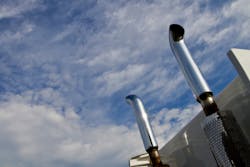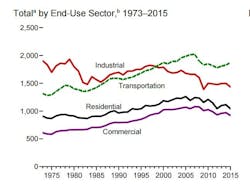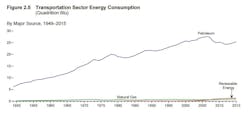Poll: 79% of Americans want tougher fuel economy standards
Three in four Americans agree that cars and trucks are a leading source of carbon pollution in the U.S., and a new poll by the Natural Resources Defense Council (NRDC) shows that respondents of all political views “overwhelmingly” endorse two Obama Administration initiatives to "put the brakes on" that climate pollutant, according to the non-profit environmental organization. The administration is pushing for cleaner cars and trucks that use less fuel and for clean transportation planning, which could usher in safe bikeways, pedestrian walkways and public transit, NRDC suggests.
NRDC’s poll finds that 77 percent of Americans think “cars and trucks contribute to the problem of air pollution” a great deal or somewhat. Additionally, 95 percent of Americans want automakers to keep improving fuel economy for cars and trucks. And 79 percent want the government to keep increasing fuel efficiency standards.
NRDC also released data ranking the states by their carbon pollution from transportation—which would be affected by the national clean transportation goals.
Of the top 20 worst emitters, seven states—California, Florida, New Jersey, Georgia, Tennessee and Virginia—generate more than 40 percent of their carbon pollution from transportation; on a national average, transportation accounts for about one-third of carbon pollution.
Also, the U.S. Department of Transportation has indicated it may issue standards this year requiring transportation planning agencies to start identifying, and then find ways to reduce, the climate and carbon pollution from projects in their transportation plans.
Indeed, California just last month issued its Sustainable Freight Action Plan, with a goal to transition to zero emission technologies.
NRDC’s poll finds that 78 percent of Americans agree that “state transportation agencies should take vehicle-related carbon pollution and climate change into account when developing transportation plans, and also seek ways to reduce that pollution.” This view is held by 92 percent of Democrats, 79 percent of Independents, and nearly two out of three (64 percent) of Republicans.
“Our poll shows Americans have just two words to say about clean transportation: ‘Floor it,’” said Pete Altman, director of Federal Campaigns at NRDC. “The Obama administration is on the right track to deliver cleaner transportation and we must resist attempts by automakers to weaken our fuel economy standards. In fact, we need to make our cars and trucks even more efficient. And we should modernize the way we plan and build the transportation systems of the future. President Obama has an opportunity, by delivering strong results, to cement a climate legacy as firmly grounded in transportation as it has been in the power sector.”
In 2012, Obama issued landmark standards for 54.5 miles-per-gallon by 2025. The administration also has implemented the first ever medium- and heavy-duty vehicle fuel efficiency standards, setting targets for 2014 and 2017 model-year trucks. A second round of greenhouse gas (GHG) regulations, looking ahead to 2027, is due to published by the Environmental Protection Agency this summer.
Currently, the roughly 400 state and municipal transportation agencies across the country that receive federal transportation funds are required to identify transportation needs, address issues like safety, and set priorities for transportation projects and budgets.
If Transportation Secretary Anthony Foxx brings forth a new national standard this year, those planning agencies would begin to take into account carbon pollution and climate impacts, which could shift their transportation plans toward reducing climate change, traffic congestion and harmful air pollution by expanding clean transportation options.
A public comment period on the possible national standard ends August 20.
But the changes can’t come soon enough for some groups.
Transportation carbon on the rise
The NRDC poll’s release coincides with a report from the U.S. Public Interest Research Group (U.S. PIRG) that says carbon emissions from the transportation sector have exceeded emissions from each of the other sectors for the first time since 1979—and the federal government needs to move forward with new rules to help limit transportation emissions.
“These recent findings are an important wake-up call that highlights the need for urgent action to combat global warming-causing pollution from transportation sources,” said John Olivieri, National Campaign Director for 21st Century Transportation at U.S. PIRG. “This is the first time in nearly 40 years that this has happened.”
The new data present both good and bad news, the consumer advocacy group points out. Carbon pollution from the electric power sector has decreased some in recent years as policymakers have focused more on reducing emissions from that sector. However, the data also show that little such progress is being made in the transportation sector. In fact, transportation sector emissions are increasing.
“It is increasingly clear that there is no path to combating climate change that doesn’t adequately address carbon pollution and other greenhouse gas emissions from transportation,” said Olivieri.
The report points to research from NASA and Duke University that found that 120,000 premature deaths could be prevented by 2030 by reducing carbon pollution from transportation. Meanwhile, MIT has calculated that as many as 53,000 lives are lost prematurely each year as a result of overall pollution from transportation sources.
Additionally, a report from Frontier Group, “A New Way Forward: Envisioning a Transportation System without Carbon Pollution” shows a variety of tools already are available that could make a zero-carbon transportation system possible. The tools outlined in the report include electrification of vehicles, increased use of shared-mobility services (car-sharing, bike-sharing, and ride-sharing), more and better public transportation, greater transit-oriented development, safe and walkable neighborhoods, and smart pricing for roads and parking, to name a few.
“While carbon pollution from transportation is a major problem, the good news is that the tools and technology we need to transition to a carbon-free transportation system already exist,” said Olivieri. “What’s needed now is the political will at the federal, state, and local levels to take meaningful action.”
About the Author
Kevin Jones 1
Editor
Kevin has served as editor-in-chief of Trailer/Body Builders magazine since 2017—just the third editor in the magazine’s 60 years. He is also editorial director for Endeavor Business Media’s Commercial Vehicle group, which includes FleetOwner, Bulk Transporter, Refrigerated Transporter, American Trucker, and Fleet Maintenance magazines and websites.



